Do not trust the email account-stealing "Email Account Is Almost Full" scam
Phishing/ScamAlso Known As: Email Account Is Almost spam
Get free scan and check if your device is infected.
Remove it nowTo use full-featured product, you have to purchase a license for Combo Cleaner. Seven days free trial available. Combo Cleaner is owned and operated by RCS LT, the parent company of PCRisk.com.
What is the "Email Account Is Almost Full" scam email message?
"Email Account Is Almost Full Scam" refers to a spam campaign, a large-scale operation during which deceptive emails are sent by the thousand. The messages distributed through the campaign in question are presented as notifications concerning a near-capacity email account.
These scam emails aim to trick recipients into attempting to sign into their mail accounts via a promote phishing website. Thus, any data (i.e., passwords) entered into the web page is exposed to the scammers.
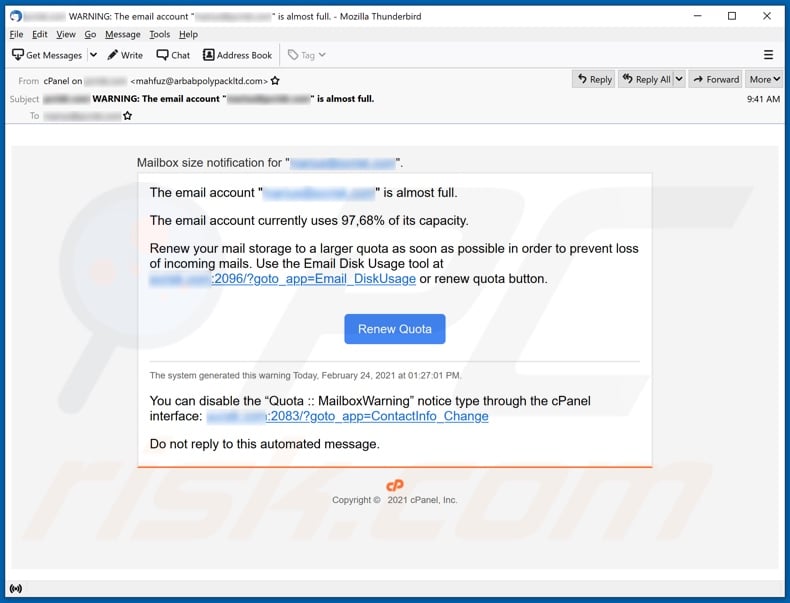
"Email Account Is Almost Full" scam overview
The scam emails with the subject/title "WARNING: The email account "********" is almost full." (this may vary) state that they are notifications concerning a particular email account. Supposedly, the mailbox has nearly reached its storage capacity (97,68% used space).
Recipients are warned that due to the overload, incoming emails may be lost. To prevent this, the scam messages urge them to renew the mail storage to a larger quota. This can be done by clicking the link or button in the emails. Note that these notification emails are fake and are in no way associated with the recipients' genuine mail service providers.
Therefore, by clicking the link/button in these messages, recipients are redirected to a phishing website. The site is disguised as a mail account sign-in page. Phishing sites operate by recording any information provided to them. I.e., the passwords typed into the page will be delivered to the scammers, thereby allowing them to hijack the corresponding email accounts.
Emails are especially targeted by scammers and cyber criminals, as they are typically connected with other accounts, platforms, and services. Therefore, through stolen email accounts, access/control can be gained over ones associated with them. To elaborate on how this can be abused - under the guise of real owners of hijacked communication platforms (e.g., emails, social networking, social media, messengers, etc.), scammers can ask contacts for loans or proliferate malware (by sharing virulent files).
Banking, digital wallet, money transferring, e-commerce, and other accounts that directly or indirectly deal with finances can be used to make fraudulent transactions and online purchases.
To summarize, by trusting the "Email Account Is Almost Full" scam, users can lose their email accounts (and associated ones), experience severe privacy issues, financial losses, and identity theft.
If attempts to log-in through the phishing web page have already been made, you are strongly advised to change the passwords of compromised accounts. Additionally, contact the official support of all potentially affected accounts/platforms.
| Name | Email Account Is Almost Full Scam |
| Threat Type | Phishing, Scam, Social Engineering, Fraud |
| Fake Claim | Emails claim the recipient's mailbox is close to reaching its storage capacity. |
| Related Domains | classy-citrine-citron.glitch[.]me |
| Detection Names (classy-citrine-citron.glitch[.]me) | AegisLab WebGuard (Phishing), Emsisoft (Phishing), Fortinet (Phishing), G-Data (Phishing), Sophos (Malware), Full List Of Detections (VirusTotal) |
| Serving IP Address (classy-citrine-citron.glitch[.]me) | 34.196.60.73 |
| Symptoms | Unauthorized online purchases, changed online account passwords, identity theft, illegal access of the computer. |
| Distribution methods | Deceptive emails, rogue online pop-up ads, search engine poisoning techniques, misspelled domains. |
| Damage | Loss of sensitive private information, monetary loss, identity theft. |
| Malware Removal (Windows) |
To eliminate possible malware infections, scan your computer with legitimate antivirus software. Our security researchers recommend using Combo Cleaner. Download Combo CleanerTo use full-featured product, you have to purchase a license for Combo Cleaner. 7 days free trial available. Combo Cleaner is owned and operated by RCS LT, the parent company of PCRisk.com. |
Phishing spam campaign examples
"TIM email scam", "Banco de Espana email scam", and "Synchronize Mail Error" are some examples of spam campaigns similar to "Email Account Is Almost Full Scam". As well as phishing, scam emails are also used to facilitate other scams and distribute malware (e.g., Trojans, ransomware, cryptominers, etc.).
These messages are usually presented as "important", "urgent", "priority", and so on, and might even be disguised as mail from legitimate institutions, companies organizations, service providers, and other entities. Due to spam mail's relative prevalence, you are strongly advised to exercise caution with incoming emails.
How do spam campaigns infect computers?
Typically, ransomware and other malware is distributed through malspam campaigns, fake software updating tools, untrusted download sources, unofficial (third party) software activation tools and Trojans. Users infect computers with malware when they open malicious files that they receive via email.
These emails often contain malicious attachments or websites designed to download dangerous files. In most cases, cyber criminals send emails that have Microsoft Office documents, archive files (ZIP, RAR), PDF documents, JavaScript files, and executable files such as .exe attached to them. Fake software updating tools do not update or fix any installed software - they simply install malware instead.
They can also infect systems by exploiting bugs/flaws of outdated software. Examples of dubious file/software download channels are Peer-to-Peer networks such as torrent clients, eMule, various free file hosting sites and freeware download websites.
Users infect computers through these channels when they download and execute malicious files, which are often disguised as legitimate and regular. Software 'cracking' tools supposedly activate licensed software free of charge (illegally), however, rather than activating anything, they often install malicious programs.
Trojans are rogue programs that, if installed, install other malware (causing chain infections).
How to avoid installation of malware
To avoid malware spread via spam mail, you are strongly advised against opening suspicious or irrelevant emails, especially those with any attachments or links present within them.
Additionally, use Microsoft Office versions released after 2010. Malicious programs also proliferate through untrusted download channels (e.g. unofficial and free file-hosting sites, Peer-to-Peer sharing networks and other third party downloaders), illegal software activation ("cracking") tools, and fake updaters.
Therefore, only download from official/verified sources and activate and update software with tools/functions provided by legitimate developers.
To ensure device integrity and user privacy, have a reputable anti-virus/anti-spyware suite installed and kept updated. Furthermore, use these programs to run regular system scans and to remove detected/potential threats.
If you have already opened malicious attachments, we recommend running a scan with Combo Cleaner Antivirus for Windows to automatically eliminate infiltrated malware.
Text presented in the "Email Account Is Almost Full" email message:
Subject: WARNING: The email account "********" is almost full.
Mailbox size notification for "********".
The email account "********" is almost full.
The email account currently uses 97,68% of its capacity.
Renew your mail storage to a larger quota as soon as possible in order to prevent loss of incoming mails. Use the Email Disk Usage tool at ********:2096/?goto_app=Email_DiskUsage or renew quota button.
Renew Quota
The system generated this warning Today, February 24, 2021 at 01:27:01 PM.
You can disable the “Quota :: MailboxWarning” notice type through the cPanel interface: ********:2083/?goto_app=ContactInfo_Change
Do not reply to this automated message.
Copyright © 2021 cPanel, Inc.
Screenshot of the phishing website promoted by the "Email Account Is Almost Full" scam:
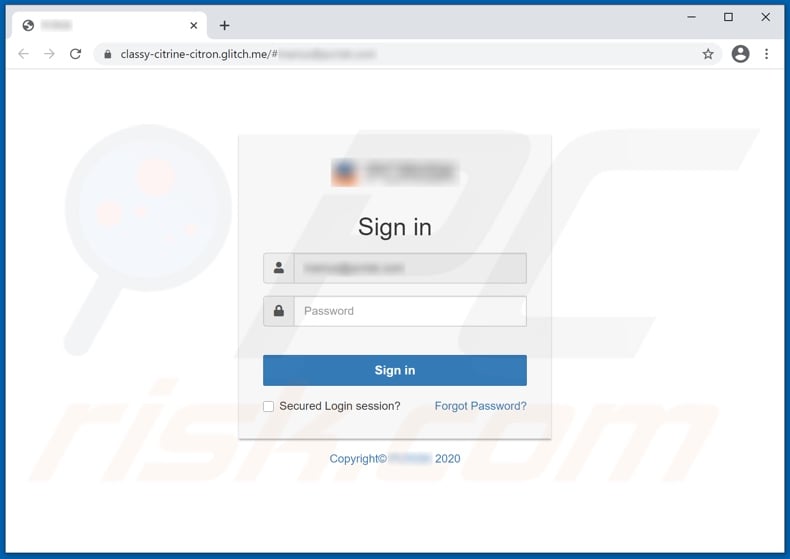
Another example of email storage-themed spam email promoting a phishing site:
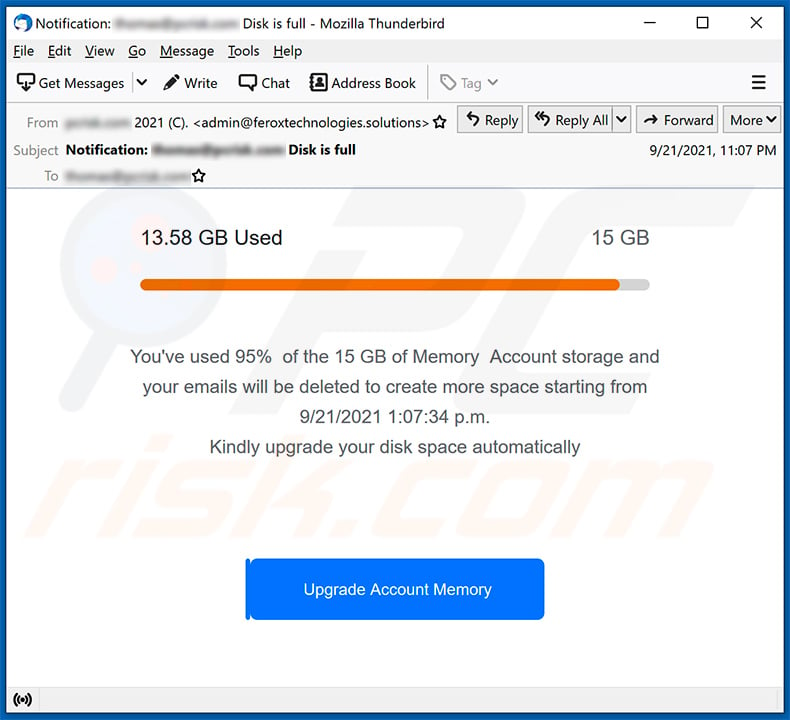
Text presented within:
Subject: Notification: - Disk is full
13.58 GB Used 15 GBYou've used 95% of the 15 GB of Memory Account storage and your emails will be deleted to create more space starting from
9/21/2021 1:07:34 p.m.
Kindly upgrade your disk space automaticallyUpgrade Account Memory
Screenshot of the promoted phishing site:
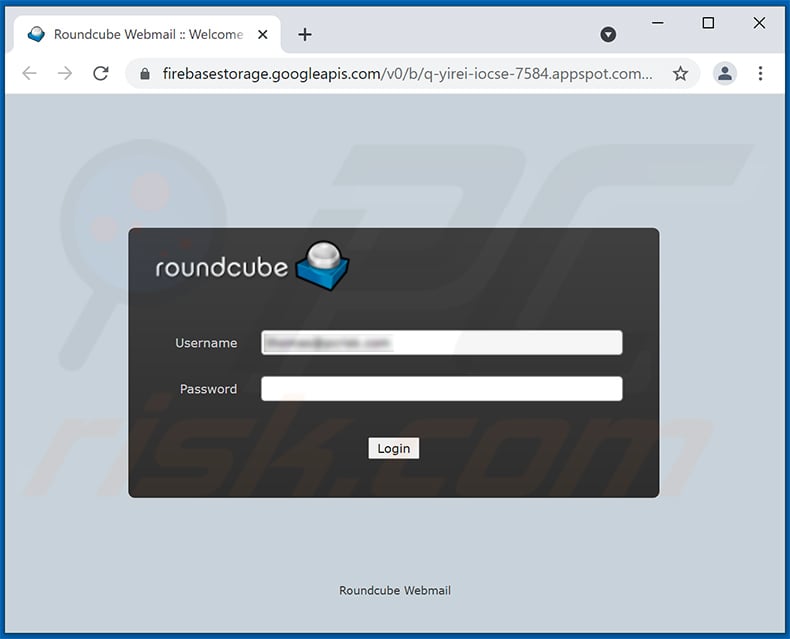
Another example of email storage-themed spam promoting a phishing website:
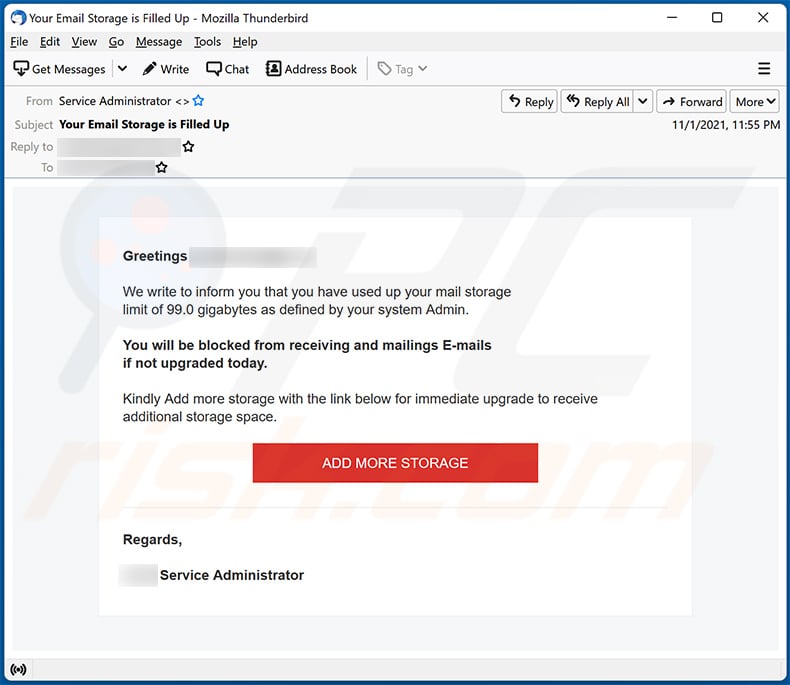
Text presented within:
Subject: Your Email Storage is Filled Up
Greetings -We write to inform you that you have used up your mail storage
limit of 99.0 gigabytes as defined by your system Admin.You will be blocked from receiving and mailings E-mails
if not upgraded today.Kindly Add more storage with the link below for immediate upgrade to receive
additional storage space.ADD MORE STORAGE
Regards,- Service Administrator
Screenshot of the promoted phishing site:
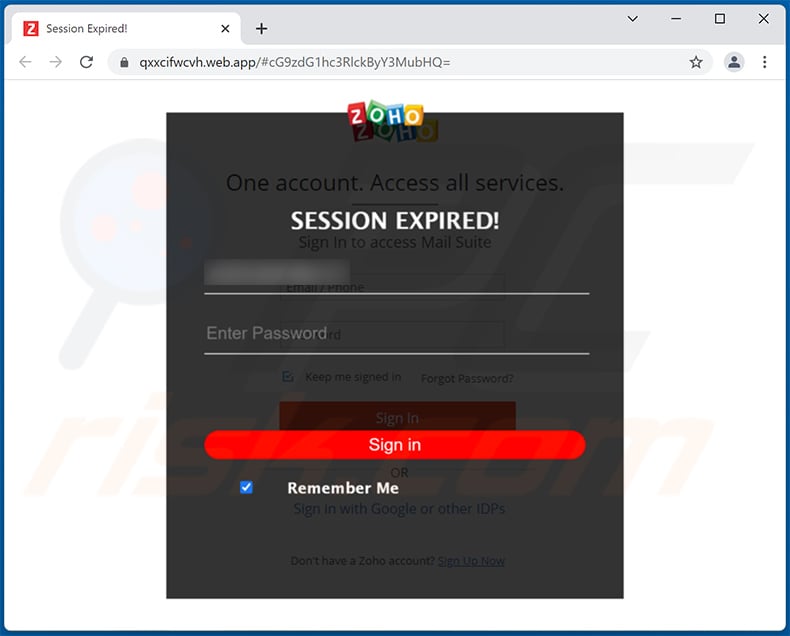
Another example of email space-themed spam email promoting a phishing site:
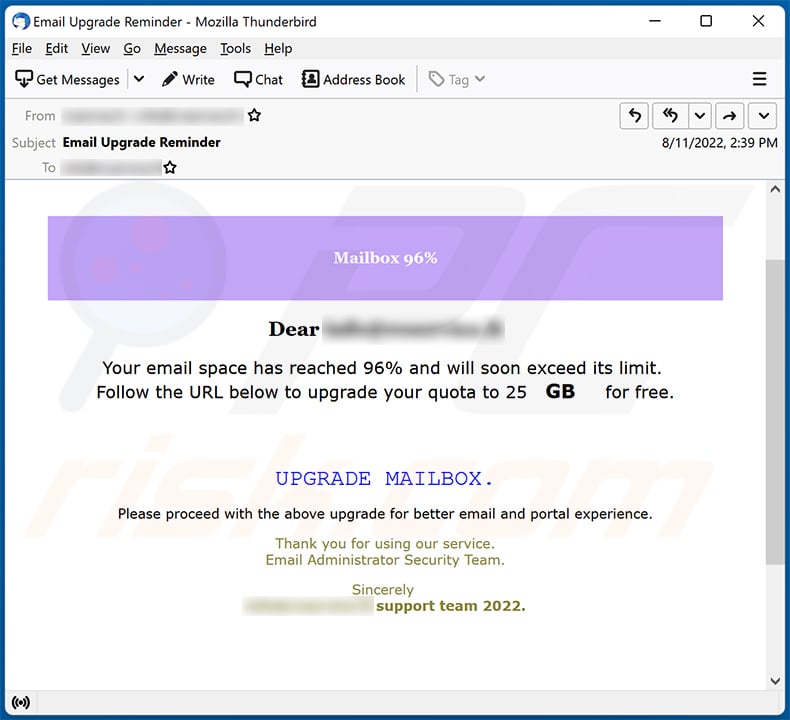
Text presented within:
Subject: Email Upgrade Reminder
Mailbox 96%
Dear ********
Your email space has reached 96% and will soon exceed its limit.
Follow the URL below to upgrade your quota to 25 GB& for free.UPGRADE MAILBOX.
Please proceed with the above upgrade for better email and portal experience.
Thank you for using our service.
Email Administrator Security Team.Sincerely
******** support team 2022.EMAIL UPDATE 2022!
EMAIL UPDATE 2022!
Yet another example of an email from "Email Account Is Almost Full" spam campaign:
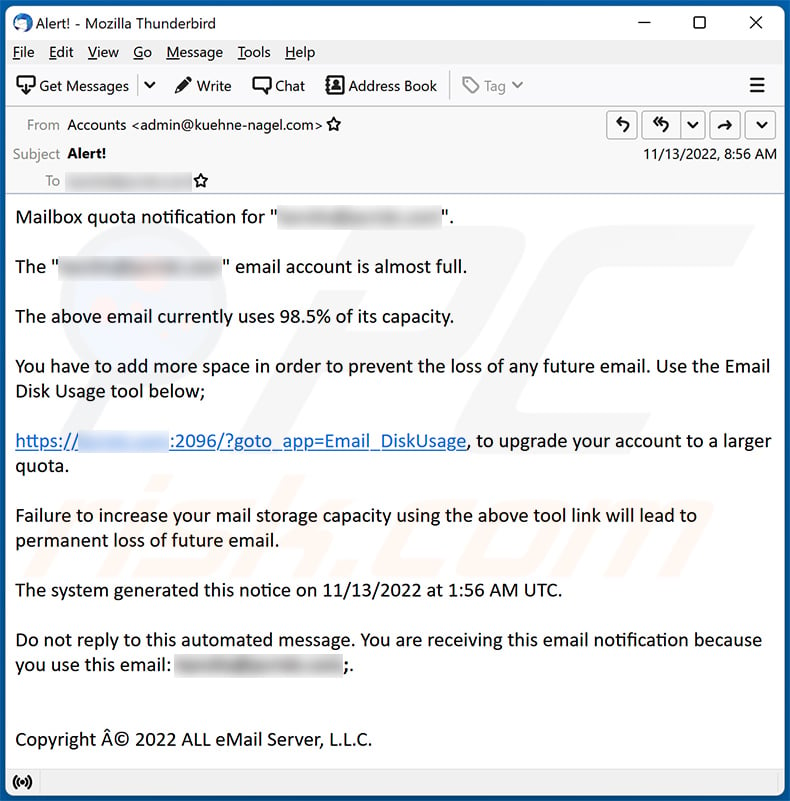
Text presented within:
Subject: Alert!
Mailbox quota notification for "********".
The "********" email account is almost full.
The above email currently uses 98.5% of its capacity.
You have to add more space in order to prevent the loss of any future email. Use the Email Disk Usage tool below;
hxxps://********:2096/?goto_app=Email_DiskUsage, to upgrade your account to a larger quota.
Failure to increase your mail storage capacity using the above tool link will lead to permanent loss of future email.
The system generated this notice on 11/13/2022 at 1:56 AM UTC.
Do not reply to this automated message. You are receiving this email notification because you use this email: ********;.
Copyright © 2022 ALL eMail Server, L.L.C.
Screenshot of the promoted phishing site designed to imitate the appearance of user's email provider:
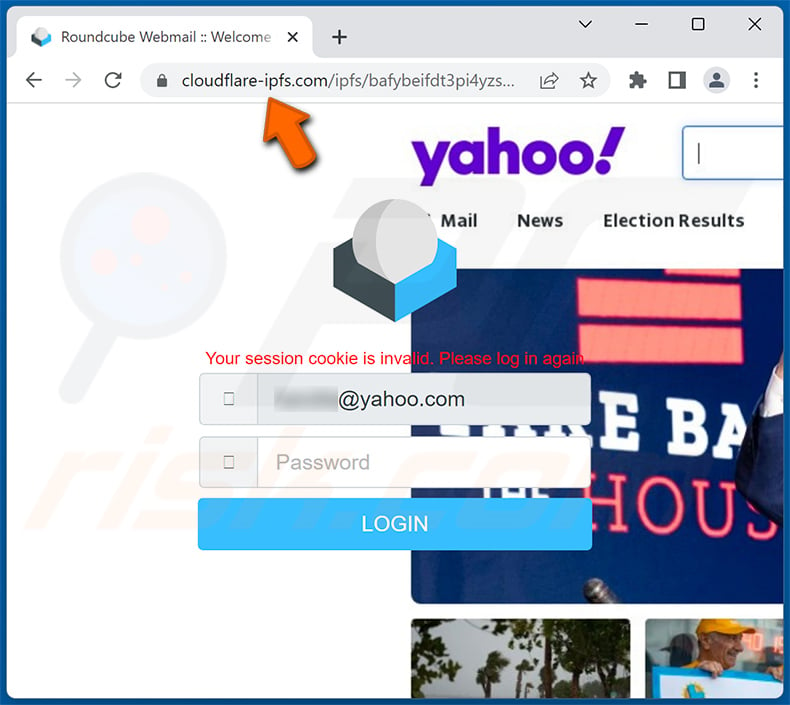
Another example of an email from "Email Account Is Almost Full" spam campaign:
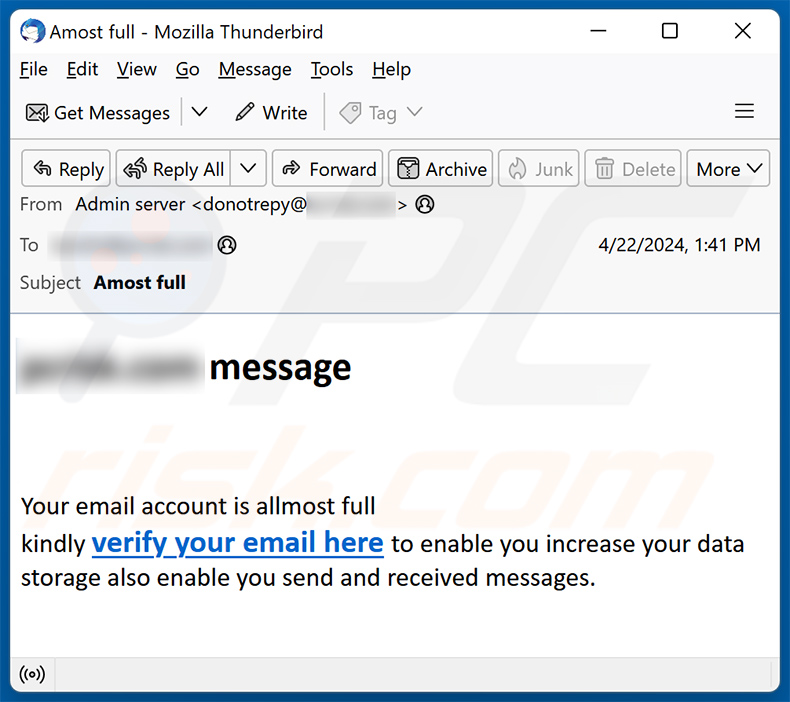
Text presented within:
Subject: Amost full
- message
Your email account is allmost full
kindly verify your email here to enable you increase your data storage also enable you send and received messages.
Screenshot of the promoted phishing site:
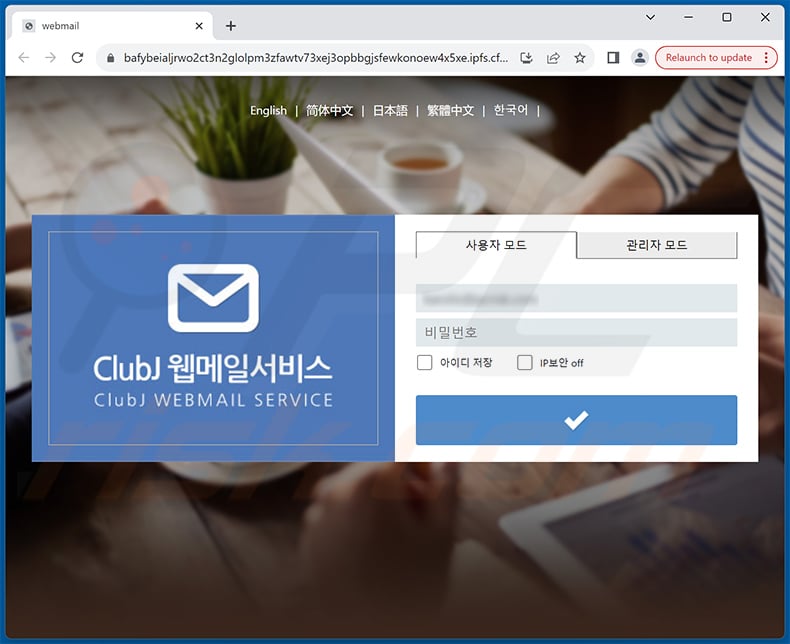
Instant automatic malware removal:
Manual threat removal might be a lengthy and complicated process that requires advanced IT skills. Combo Cleaner is a professional automatic malware removal tool that is recommended to get rid of malware. Download it by clicking the button below:
DOWNLOAD Combo CleanerBy downloading any software listed on this website you agree to our Privacy Policy and Terms of Use. To use full-featured product, you have to purchase a license for Combo Cleaner. 7 days free trial available. Combo Cleaner is owned and operated by RCS LT, the parent company of PCRisk.com.
Quick menu:
- What is Email Account Is Almost spam?
- Types of malicious emails.
- How to spot a malicious email?
- What to do if you fell for an email scam?
Types of malicious emails:
![]() Phishing Emails
Phishing Emails
Most commonly, cybercriminals use deceptive emails to trick Internet users into giving away their sensitive private information, for example, login information for various online services, email accounts, or online banking information.
Such attacks are called phishing. In a phishing attack, cybercriminals usually send an email message with some popular service logo (for example, Microsoft, DHL, Amazon, Netflix), create urgency (wrong shipping address, expired password, etc.), and place a link which they hope their potential victims will click on.
After clicking the link presented in such email message, victims are redirected to a fake website that looks identical or extremely similar to the original one. Victims are then asked to enter their password, credit card details, or some other information that gets stolen by cybercriminals.
![]() Emails with Malicious Attachments
Emails with Malicious Attachments
Another popular attack vector is email spam with malicious attachments that infect users' computers with malware. Malicious attachments usually carry trojans that are capable of stealing passwords, banking information, and other sensitive information.
In such attacks, cybercriminals' main goal is to trick their potential victims into opening an infected email attachment. To achieve this goal, email messages usually talk about recently received invoices, faxes, or voice messages.
If a potential victim falls for the lure and opens the attachment, their computers get infected, and cybercriminals can collect a lot of sensitive information.
While it's a more complicated method to steal personal information (spam filters and antivirus programs usually detect such attempts), if successful, cybercriminals can get a much wider array of data and can collect information for a long period of time.
![]() Sextortion Emails
Sextortion Emails
This is a type of phishing. In this case, users receive an email claiming that a cybercriminal could access the webcam of the potential victim and has a video recording of one's masturbation.
To get rid of the video, victims are asked to pay a ransom (usually using Bitcoin or another cryptocurrency). Nevertheless, all of these claims are false - users who receive such emails should ignore and delete them.
How to spot a malicious email?
While cyber criminals try to make their lure emails look trustworthy, here are some things that you should look for when trying to spot a phishing email:
- Check the sender's ("from") email address: Hover your mouse over the "from" address and check if it's legitimate. For example, if you received an email from Microsoft, be sure to check if the email address is @microsoft.com and not something suspicious like @m1crosoft.com, @microsfot.com, @account-security-noreply.com, etc.
- Check for generic greetings: If the greeting in the email is "Dear user", "Dear @youremail.com", "Dear valued customer", this should raise suspiciousness. Most commonly, companies call you by your name. Lack of this information could signal a phishing attempt.
- Check the links in the email: Hover your mouse over the link presented in the email, if the link that appears seems suspicious, don't click it. For example, if you received an email from Microsoft and the link in the email shows that it will go to firebasestorage.googleapis.com/v0... you shouldn't trust it. It's best not to click any links in the emails but to visit the company website that sent you the email in the first place.
- Don't blindly trust email attachments: Most commonly, legitimate companies will ask you to log in to their website and to view any documents there; if you received an email with an attachment, it's a good idea to scan it with an antivirus application. Infected email attachments are a common attack vector used by cybercriminals.
To minimise the risk of opening phishing and malicious emails we recommend using Combo Cleaner Antivirus for Windows.
Example of a spam email:

What to do if you fell for an email scam?
- If you clicked on a link in a phishing email and entered your password - be sure to change your password as soon as possible. Usually, cybercriminals collect stolen credentials and then sell them to other groups that use them for malicious purposes. If you change your password in a timely manner, there's a chance that criminals won't have enough time to do any damage.
- If you entered your credit card information - contact your bank as soon as possible and explain the situation. There's a good chance that you will need to cancel your compromised credit card and get a new one.
- If you see any signs of identity theft - you should immediately contact the Federal Trade Commission. This institution will collect information about your situation and create a personal recovery plan.
- If you opened a malicious attachment - your computer is probably infected, you should scan it with a reputable antivirus application. For this purpose, we recommend using Combo Cleaner Antivirus for Windows.
- Help other Internet users - report phishing emails to Anti-Phishing Working Group, FBI’s Internet Crime Complaint Center, National Fraud Information Center and U.S. Department of Justice.
Frequently Asked Questions (FAQ)
Why did I receive this email?
Cyber criminals distribute this mail in large-scale operations. Therefore, thousands of users receive identical spam emails.
I have provided my personal information when tricked by this spam email, what should I do?
If you've disclosed log-in credentials - change the passwords of all potentially exposed accounts and inform their official support without delay. However, if you have provided other private data (e.g., ID card details, credit card numbers, etc.) - immediately contact the appropriate authorities.
I have read a spam email but didn't open the attachment, is my computer infected?
No, opening/reading an email is safe. Infections are triggered when the attachments or links present in spam mail are opened/clicked.
I have downloaded and opened a file attached to a spam email, is my computer infected?
Whether your device was infected can depend on the file's purpose and format. Executables trigger malware download/installation almost without fail once opened. However, document formats (.doc, .xls, .pdf, etc.) might need additional user interaction (e.g., enabling macro commands) to initiate infection processes.
Will Combo Cleaner remove malware infections present in email attachments?
Yes, Combo Cleaner can detect and eliminate most of the known malware infections. It must be stressed that since sophisticated malicious software usually hides deep within systems - performing a full system scan is essential.
Share:

Tomas Meskauskas
Expert security researcher, professional malware analyst
I am passionate about computer security and technology. I have an experience of over 10 years working in various companies related to computer technical issue solving and Internet security. I have been working as an author and editor for pcrisk.com since 2010. Follow me on Twitter and LinkedIn to stay informed about the latest online security threats.
PCrisk security portal is brought by a company RCS LT.
Joined forces of security researchers help educate computer users about the latest online security threats. More information about the company RCS LT.
Our malware removal guides are free. However, if you want to support us you can send us a donation.
DonatePCrisk security portal is brought by a company RCS LT.
Joined forces of security researchers help educate computer users about the latest online security threats. More information about the company RCS LT.
Our malware removal guides are free. However, if you want to support us you can send us a donation.
Donate
▼ Show Discussion